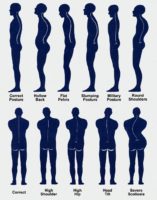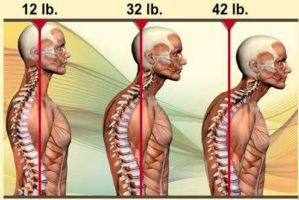 Quick – what’s the first thing you think of when you hear the word “posture?” A soldier standing at attention? Shoulders pulled back, chin tucked in, legs snapped together, butt tight? Or perhaps a ballet dancer, long, lean and upright? The first picture that comes to my mind is straight out of a Jane Austen novel – a young woman standing and balancing a book on her head (thanks Mom). For many people, posture is a static concept – something to hold on to to create a pleasing aesthetic. But guess what? Posture is anything BUT static! Posture involves balancing the structure of the human body against the forces of gravity, load and velocity. Posture is a dynamic process, constantly shifting and moving to create the best possible conditions in your body for optimum support and motion. Understand this: if your posture is terrible in a standing or sitting position, then your movement is likely impaired in some way too.
Quick – what’s the first thing you think of when you hear the word “posture?” A soldier standing at attention? Shoulders pulled back, chin tucked in, legs snapped together, butt tight? Or perhaps a ballet dancer, long, lean and upright? The first picture that comes to my mind is straight out of a Jane Austen novel – a young woman standing and balancing a book on her head (thanks Mom). For many people, posture is a static concept – something to hold on to to create a pleasing aesthetic. But guess what? Posture is anything BUT static! Posture involves balancing the structure of the human body against the forces of gravity, load and velocity. Posture is a dynamic process, constantly shifting and moving to create the best possible conditions in your body for optimum support and motion. Understand this: if your posture is terrible in a standing or sitting position, then your movement is likely impaired in some way too.
There are a multitude of factors involved in what we know as “posture.” Let’s start with one of the most obvious – the support of the spine. The vertebrae in the spine are organized in such a way that they create several curves – a concave cervical curve (your neck), a convex thoracic curve (your rib cage area), a concave lumbar curve (low back), and a convex sacral curve. These curves have evolved over thousands of years of bipedal human motion to give a certain buoyancy to the body. They act a little bit like a spring. They absorb and transmit vertical forces, rotational forces, and other directional loads & forces at play on the body as it stands and moves itself through space. But for this spring-like effect to work well, especially in relation to other joints in the body, those curves need to be properly balanced and well supported. When they’re not, the spring can’t sproing very well. Why should you care? Here are 5 BIG reasons why it’s worth your while:
 1. JOINT FUNCTION:When the spine is aligned properly, the shoulder girdle can hang easily on the rib cage for efficient recruitment of the appropriate muscles for any given motion. When the spinal curves are unbalanced, shoulder stability is diminished, mobility is impaired and the thorax may become over-involved in the motion of the arms. If you’re a baseball player, your throwing performance will be impacted. If you’re a mother, lifting a small child, you may find shoulder and neck pain creeps up over time. If you’re a yoga devotee, that downward facing dog may become a real challenge.
1. JOINT FUNCTION:When the spine is aligned properly, the shoulder girdle can hang easily on the rib cage for efficient recruitment of the appropriate muscles for any given motion. When the spinal curves are unbalanced, shoulder stability is diminished, mobility is impaired and the thorax may become over-involved in the motion of the arms. If you’re a baseball player, your throwing performance will be impacted. If you’re a mother, lifting a small child, you may find shoulder and neck pain creeps up over time. If you’re a yoga devotee, that downward facing dog may become a real challenge.
When the spine is aligned properly, the pelvis and legs can hang easily for efficient function. If the spine is not well organized, the pelvis and legs cannot easily dissociate to work well independently. This will often result in over-recruitment of low back muscles, hip flexors, adductors (inner thighs) and butt. If you’re a runner, this doesn’t bode well for the free cycling of the legs underneath you in your gait! If you’re a hockey player, the agility, power and speed of your skating will be affected. If you’re a dancer… well, you get the idea.
2. HEAD BALANCE:
 Let’s talk about the head for a moment. In an ideal postural situation, the head is balanced easily over the spine. When the spinal curves are altered somehow, by bad training, inattention, lack of movement, injury or whatever, then the head will often fall away from the mid-line of the spine, where it becomes much harder to support. Imagine holding a bowling ball in one hand, close to your body. Heavy enough, but not unmanageable, right? Now try extending the arm, so that you are holding that same bowling ball far away from your mid-line. How does that feel? A little harder to support? Of course it does! The further the head moves away from your centre, the heavier it feels and the harder the rest of your structure has to work to support it! Imagine the energy you are expending simply to hold up the weight of your head!
Let’s talk about the head for a moment. In an ideal postural situation, the head is balanced easily over the spine. When the spinal curves are altered somehow, by bad training, inattention, lack of movement, injury or whatever, then the head will often fall away from the mid-line of the spine, where it becomes much harder to support. Imagine holding a bowling ball in one hand, close to your body. Heavy enough, but not unmanageable, right? Now try extending the arm, so that you are holding that same bowling ball far away from your mid-line. How does that feel? A little harder to support? Of course it does! The further the head moves away from your centre, the heavier it feels and the harder the rest of your structure has to work to support it! Imagine the energy you are expending simply to hold up the weight of your head!
3. BREATHING:If your posture tends toward the slouchy side, then you will be creating a situation where your respiratory diaphragm, the main breathing muscle, cannot work effectively. To do its job well, the respiratory diaphragm needs to have a good vertical excursion inside the body (a little like the action of a piston), and the ability to laterally open the rib cage to expand the lungs. If this isn’t happening in your body, then there is a problem. Because breathing is Job #1 in the body. To make sure you get the air you need to survive, all kinds of other muscles will come into play to take up the slack. Neck muscles, shoulder muscles, back muscles – all these accessories will do whatever they have to do to create an environment where breathing can occur. They are valiant in their efforts – but they don’t do the job nearly as well as the diaphragm. Not only is respiration less efficient, but the accessory musculature can no longer do their own jobs as well either. (Muscles don’t multi-task any better than we do).
4. CORE STABILITY & VISCERAL FUNCTIONIf you’re a sloucher, then the forward hanging position of your upper body will put pressure on your abdominal organs. The viscera are contained in a fascial bag called the peritoneum, which in many ways resembles a water balloon. And much like a water balloon, this bag cannot be compressed. Picture what happens when you squeeze a water balloon: the balloon and its contents squish out one one side or the other – they don’t just get smaller between your hands. The same is true of your own abdominal organs. Too much intra-abdominal pressure means that the “water balloon” gets squished out somewhere else. In your body, that somewhere is likely either the abdominal wall (creating that “pooch” in the belly), or in the pelvic floor (making it hard to laugh without peeing). That added pressure makes it virtually impossible to recruit the deep abdominal wall and creates serious issues for pelvic floor control. What does THAT do for your core training program? And with too much pressure bearing down on the organs, the organs themselves will have trouble optimally performing the jobs THEY were designed to do!
5. NERVOUS SYSTEM FUNCTIONYour spinal cord, largely contained within the spinal column, provides a running channel of electrical information between your brain and the rest of the body. That information travels through nerves that radiate out from the spinal cord. Poor spinal alignment can create challenges for the efficient transfer of information from brain to body and body to brain. Those challenges can manifest as poor neuromuscular control, sensory amnesia, numbness, pain and any number of other symptoms. Optimal posture is important for the efficiency of the neuromuscular system in organizing movement.
The trick is to remember that posture is a constantly shifting and evolving process. You can’t just set it to “on” and forget about it. Posture responds and adjusts to what you’re doing, the load demands you’re placing on the body, the mood you’re in, your overall health, and many other factors. Start paying attention to what happens to your posture in different situations. There may be places that you support it well, and other places that need some work.
I encourage you to get to know your own posture! Start out by finding some length in your spine. Feel the floor with your feet, reach to the sky with the crown of your head. Good posture will make everything else feel easier. If it feels stiff or hard to hold, then you’re probably trying too hard. Find ease, length and balance. That old trick your mama taught you? The one where you balance a book on your head and walk across the room? Well – it’s not a bad place to start!
If you’re interested in exploring your own posture more deeply, I’d like to recommend a great resource: “The New Rules of Posture: How to Sit, Stand, and Move in the Modern World” by Mary Bond. It’s a fabulous book; accessible and well-written. It’s got exercises you can play with to feel where you are in your own posture, and how to create more ease in your body.
Today, as an added bonus, I thought I’d share with you an episode of my internet radio show, “Alive! Bodies in Motion,” from July, 2010. In this episode, entitled, “From the Inside Out: Core Strength & Posture,” I had a great conversation with Marie-Jose Blom, master Pilates educator, about how important it is to develop and maintain good core strength and posture. Important not just for the obvious aesthetic appeal, but for our overall health and wellbeing. I hope you enjoy it!
Alive! Bodies in Motion – Episode # 8 – From the Inside Out, Core Strength & Posture, with Marie Jose Blom & host, Susannah Steers
